手写Spring MVC框架 实现简易版mvc框架
Posted blayn
tags:
篇首语:本文由小常识网(cha138.com)小编为大家整理,主要介绍了手写Spring MVC框架 实现简易版mvc框架相关的知识,希望对你有一定的参考价值。
前言
前面几篇文章中,我们讲解了Spring MVC执⾏的⼤致原理及关键组件的源码解析,今天,我们来模仿它⼿写⾃⼰的mvc框架。
先梳理一下需要实现的功能点:
- tomcat加载配置文件web.xml;
- 调用web.xml中指定的前端控制器DispatcherServlet加载指定的配置文件(一般为springmvc.xml,本文中的为springmvc.properties);
- 扫描相关的类,扫描注解(@Controller,@Service,@RequestMapping,@Autowired);
- IOC容器进行相应Bean初始化以及依赖注入维护;
- Spring MVC相关组件的初始化,建立url与method之间的映射关系——HandlerMapping(处理器映射器);
- 等待请求进来,处理请求。
实现过程
闲话少说,直接来看代码。
1、注解开发
HardyController:
package com.hardy.edu.mvcframework.annotations; import java.lang.annotation.*; @Documented // 表明这个注解应该被 javadoc 工具记录 @Target(ElementType.TYPE) // 用于设定注解使用范围,ElementType.TYPE标明该注解可用于类或者接口上,用于描述类、接口(包括注解类型) 或enum声明 @Retention(RetentionPolicy.RUNTIME) // 指定生存周期,运行时有效 public @interface HardyController { String value() default ""; }
HardyService:
package com.hardy.edu.mvcframework.annotations; import java.lang.annotation.*; @Documented @Target(ElementType.TYPE) @Retention(RetentionPolicy.RUNTIME) public @interface HardyService { String value() default ""; }
HardyRequestMapping:
package com.hardy.edu.mvcframework.annotations; import java.lang.annotation.*; @Documented @Target({ElementType.TYPE,ElementType.METHOD}) // 可用于类、接口或方法上 @Retention(RetentionPolicy.RUNTIME) public @interface HardyRequestMapping { String value() default ""; }
HardyAutowired:
package com.hardy.edu.mvcframework.annotations; import java.lang.annotation.*; @Documented @Target(ElementType.FIELD) // 可用于域上,用于描述域 @Retention(RetentionPolicy.RUNTIME) public @interface HardyAutowired { String value() default ""; }
2、Pojo类Handler
package com.hardy.edu.mvcframework.pojo; import java.lang.reflect.Method; import java.util.HashMap; import java.util.Map; import java.util.regex.Pattern; /** * @author HardyYao * @date 2021/5/13 * @description 封装handler方法相关的信息 */ public class Handler { private Object controller; // method.invoke(obj,) private Method method; private Pattern pattern; // spring中url是支持正则的 private Map<String,Integer> paramIndexMapping; // 参数顺序,是为了进行参数绑定,key是参数名,value代表是第几个参数 此次测试中我们传递的参数那么的map为:<name,2> public Handler(Object controller, Method method, Pattern pattern) { this.controller = controller; this.method = method; this.pattern = pattern; this.paramIndexMapping = new HashMap<>(); } public Object getController() { return controller; } public void setController(Object controller) { this.controller = controller; } public Method getMethod() { return method; } public void setMethod(Method method) { this.method = method; } public Pattern getPattern() { return pattern; } public void setPattern(Pattern pattern) { this.pattern = pattern; } public Map<String, Integer> getParamIndexMapping() { return paramIndexMapping; } public void setParamIndexMapping(Map<String, Integer> paramIndexMapping) { this.paramIndexMapping = paramIndexMapping; } }
3、前端控制器实现
package com.hardy.edu.mvcframework.servlet; import com.hardy.edu.mvcframework.annotations.HardyAutowired; import com.hardy.edu.mvcframework.annotations.HardyController; import com.hardy.edu.mvcframework.annotations.HardyRequestMapping; import com.hardy.edu.mvcframework.annotations.HardyService; import com.hardy.edu.mvcframework.pojo.Handler; import org.apache.commons.lang3.StringUtils; import javax.servlet.ServletConfig; import javax.servlet.ServletException; import javax.servlet.http.HttpServlet; import javax.servlet.http.HttpServletRequest; import javax.servlet.http.HttpServletResponse; import java.io.File; import java.io.IOException; import java.io.InputStream; import java.lang.reflect.Field; import java.lang.reflect.InvocationTargetException; import java.lang.reflect.Method; import java.lang.reflect.Parameter; import java.util.*; import java.util.regex.Matcher; import java.util.regex.Pattern; /** * @author HardyYao * @date 2021/5/13 * @description 前端控制器 */ public class HardyDispatcherServlet extends HttpServlet { private Properties properties = new Properties(); // 缓存扫描到的类的全限定类名 private List<String> classNames = new ArrayList<>(); // ioc容器 private Map<String,Object> ioc = new HashMap<>(); // handlerMapping private List<Handler> handlerMapping = new ArrayList<>(); @Override public void init(ServletConfig config) throws ServletException { // 1 加载配置文件 springmvc.properties String contextConfigLocation = config.getInitParameter("contextConfigLocation"); doLoadConfig(contextConfigLocation); // 2 扫描相关的类,扫描注解 doScan(properties.getProperty("scanPackage")); // 3 初始化bean对象(实现ioc容器,基于注解) doInstance(); // 4 实现依赖注入 doAutoWired(); // 5 构造一个HandlerMapping处理器映射器,将配置好的url和Method建立映射关系 initHandlerMapping(); System.out.println("hardy mvc 初始化完成...."); // 6 等待请求进入,处理请求 } /** * 构造一个HandlerMapping处理器映射器 * 这是最关键的环节 * 目的:将url和method建立关联 */ private void initHandlerMapping() { if (ioc.isEmpty()) { return ; } for(Map.Entry<String,Object> entry: ioc.entrySet()) { // 获取ioc中当前遍历的对象的class类型 Class<?> aClass = entry.getValue().getClass(); if(!aClass.isAnnotationPresent(HardyController.class)) {continue;} String baseUrl = ""; if(aClass.isAnnotationPresent(HardyRequestMapping.class)) { HardyRequestMapping annotation = aClass.getAnnotation(HardyRequestMapping.class); baseUrl = annotation.value(); // 等同于/demo } // 获取方法 Method[] methods = aClass.getMethods(); for (int i = 0; i < methods.length; i++) { Method method = methods[i]; // 方法没有标识HardyRequestMapping,就不处理 if(!method.isAnnotationPresent(HardyRequestMapping.class)) {continue;} // 如果标识,就处理 HardyRequestMapping annotation = method.getAnnotation(HardyRequestMapping.class); String methodUrl = annotation.value(); // /query String url = baseUrl + methodUrl; // 计算出来的url /demo/query // 把method所有信息及url封装为一个Handler Handler handler = new Handler(entry.getValue(),method, Pattern.compile(url)); // 计算方法的参数位置信息 // query(HttpServletRequest request, HttpServletResponse response,String name) Parameter[] parameters = method.getParameters(); for (int j = 0; j < parameters.length; j++) { Parameter parameter = parameters[j]; if(parameter.getType() == HttpServletRequest.class || parameter.getType() == HttpServletResponse.class) { // 如果是request和response对象,那么参数名称写HttpServletRequest和HttpServletResponse handler.getParamIndexMapping().put(parameter.getType().getSimpleName(),j); }else{ handler.getParamIndexMapping().put(parameter.getName(),j); // <name,2> } } // 建立url和method之间的映射关系(map缓存起来) handlerMapping.add(handler); } } } /** * 实现依赖注入 */ private void doAutoWired() { // 如果对象为空,则直接返回 if (ioc.isEmpty()) { return ; } // 有对象,则进行依赖注入处理 // 遍历ioc中所有对象,查看对象中的字段,是否有@HardyAutowired注解,如果有需要维护依赖注入关系 for (Map.Entry<String,Object> entry: ioc.entrySet()) { // 获取bean对象中的字段信息 Field[] declaredFields = entry.getValue().getClass().getDeclaredFields(); // 遍历判断处理 for (int i = 0; i < declaredFields.length; i++) { Field declaredField = declaredFields[i]; // @HardyAutowired private IDemoService demoService; if (!declaredField.isAnnotationPresent(HardyAutowired.class)) { continue; } // 有该注解 HardyAutowired annotation = declaredField.getAnnotation(HardyAutowired.class); String beanName = annotation.value(); // 需要注入的bean的id if ("".equals(beanName.trim())) { // 没有配置具体的bean id,那就需要根据当前字段类型注入(接口注入) IDemoService beanName = declaredField.getType().getName(); } // 开启赋值 declaredField.setAccessible(true); try { declaredField.set(entry.getValue(), ioc.get(beanName)); } catch (IllegalAccessException e) { e.printStackTrace(); } } } } /** * ioc容器:基于classNames缓存的类的全限定类名,以及反射技术,完成对象创建和管理 * */ private void doInstance() { if (classNames.size() == 0) { return ; } try{ for (int i = 0; i < classNames.size(); i++) { String className = classNames.get(i); // com.hardy.demo.controller.DemoController // 反射 Class<?> aClass = Class.forName(className); // 区分controller,区分service\' if(aClass.isAnnotationPresent(HardyController.class)) { // controller的id此处不做过多处理,不取value了,就拿类的首字母小写作为id,保存到ioc中 String simpleName = aClass.getSimpleName();// DemoController String lowerFirstSimpleName = lowerFirst(simpleName); // demoController Object o = aClass.newInstance(); ioc.put(lowerFirstSimpleName,o); }else if(aClass.isAnnotationPresent(HardyService.class)) { HardyService annotation = aClass.getAnnotation(HardyService.class); //获取注解value值 String beanName = annotation.value(); // 如果指定了id,就以指定的为准 if(!"".equals(beanName.trim())) { ioc.put(beanName,aClass.newInstance()); }else{ // 如果没有指定,就以类名首字母小写 beanName = lowerFirst(aClass.getSimpleName()); ioc.put(beanName,aClass.newInstance()); } // service层往往是有接口的,面向接口开发,此时再以接口名为id,放入一份对象到ioc中,便于后期根据接口类型注入 Class<?>[] interfaces = aClass.getInterfaces(); for (int j = 0; j < interfaces.length; j++) { Class<?> anInterface = interfaces[j]; // 以接口的全限定类名作为id放入 ioc.put(anInterface.getName(),aClass.newInstance()); } } else{ continue; } } } catch (Exception e) { e.printStackTrace(); } } /** * 首字母小写方法 * @param str * @return */ public String lowerFirst(String str) { char[] chars = str.toCharArray(); if (\'A\' <= chars[0] && chars[0] <= \'Z\') { chars[0] += 32; } return String.valueOf(chars); } /** * 扫描类:scanPackage: com.hardy.demo package----> 磁盘上的文件夹(File) com/hardy/demo * @param scanPackage */ private void doScan(String scanPackage) { String scanPackagePath = Thread.currentThread().getContextClassLoader().getResource("").getPath() + scanPackage.replaceAll("\\\\.", "/"); File pack = new File(scanPackagePath); File[] files = pack.listFiles(); if (files != null && files.length > 0) { for (File file: files) { if(file.isDirectory()) { // 子package // 递归 doScan(scanPackage + "." + file.getName()); // com.hardy.demo.controller }else if(file.getName().endsWith(".class")) { String className = scanPackage + "." + file.getName().replaceAll(".class", ""); classNames.add(className); } } } } /** * 加载配置文件 * @param contextConfigLocation */ private void doLoadConfig(String contextConfigLocation) { InputStream resourceAsStream = this.getClass().getClassLoader().getResourceAsStream(contextConfigLocation); try { properties.load(resourceAsStream); } catch (IOException e) { e.printStackTrace(); } } /** * 接收处理请求 * @param req * @param resp * @throws ServletException * @throws IOException */ @Override protected void doGet(HttpServletRequest req, HttpServletResponse resp) throws ServletException, IOException { doPost(req, resp); } @Override protected void doPost(HttpServletRequest req, HttpServletResponse resp) throws ServletException, IOException { // 处理请求:根据url,找到对应的Method方法,进行调用 // 获取uri // String requestURI = req.getRequestURI(); // Method method = handlerMapping.get(requestURI);// 获取到一个反射的方法 // 反射调用,需要传入对象,需要传入参数,此处无法完成调用,没有把对象缓存起来,也没有参数!!!!改造initHandlerMapping(); // method.invoke() // // 根据uri获取到能够处理当前请求的hanlder(从handlermapping中(list)) Handler handler = getHandler(req); // handler为空则返回:404 not found if (handler == null) { resp.getWriter().write("404 not found"); return; } // 参数绑定 // 获取所有参数类型数组,这个数组的长度就是我们最后要传入的args数组的长度 Class<?>[] parameterTypes = handler.getMethod().getParameterTypes(); // 根据上述数组长度创建一个新的数组(参数数组,是要传入反射调用的) Object[] paraValues = new Object[parameterTypes.length]; // 以下就是为了向参数数组中塞值,而且还得保证参数的顺序和方法中形参顺序一致 Map<String, String[]> parameterMap = req.getParameterMap(); // 遍历request中所有参数 (填充除了request,response之外的参数) for (Map.Entry<String,String[]> param: parameterMap.entrySet()) { // name=1&name=2 name [1,2] String value = StringUtils.join(param.getValue(), ","); // 如同 1,2 // 如果参数和方法中的参数匹配上了,填充数据 if (!handler.getParamIndexMapping().containsKey(param.getKey())) { continue ; } // 方法形参确实有该参数,找到它的索引位置,对应的把参数值放入paraValues Integer index = handler.getParamIndexMapping().get(param.getKey());//name在第 2 个位置 paraValues[index] = value; // 把前台传递过来的参数值填充到对应的位置去 } int requestIndex = handler.getParamIndexMapping().get(HttpServletRequest.class.getSimpleName()); // 0 paraValues[requestIndex] = req; int responseIndex = handler.getParamIndexMapping().get(HttpServletResponse.class.getSimpleName()); // 1 paraValues[responseIndex] = resp; // 最终调用handler的method属性 try { handler.getMethod().invoke(handler.getController(), paraValues); } catch (IllegalAccessException e) { e.printStackTrace(); } catch (InvocationTargetException e) { e.printStackTrace(); } } private Handler getHandler(HttpServletRequest req) { // 为空则直接返回null if (handlerMapping.isEmpty()) { return null; } String url = req.getRequestURI(); // 遍历handlerMapping for (Handler handler : handlerMapping) { // pattern封装了url,判断其是否匹配url Matcher matcher = handler.getPattern().matcher(url); // 不匹配则跳过 if (!matcher.matches()) { continue; } // 匹配则返回handler return handler; } return null; } }
4、web.xml配置
<!DOCTYPE web-app PUBLIC "-//Sun Microsystems, Inc.//DTD Web Application 2.3//EN" "http://java.sun.com/dtd/web-app_2_3.dtd" > <web-app> <display-name>Archetype Created Web Application</display-name> <!-- 配置servlet --> <servlet> <servlet-name>hardymvc</servlet-name> <servlet-class>com.hardy.edu.mvcframework.servlet.HardyDispatcherServlet</servlet-class> <!-- servlet需要加载的配置文件--> <init-param> <param-name>contextConfigLocation</param-name> <param-value>springmvc.properties</param-value> </init-param> </servlet> <!-- 配置映射,拦截所有 --> <servlet-mapping> <servlet-name>hardymvc</servlet-name> <url-pattern>/*</url-pattern> </servlet-mapping> </web-app>
5、springmvc.properties
scanPackage=com.hardy.demo
调用过程
IDemoService:
package com.hardy.demo.service; /** * @author HardyYao * @date 2021/5/13 * @description */ public interface IDemoService { String get(String name);
}
DemoServiceImpl:
package com.hardy.demo.service.impl; import com.hardy.demo.service.IDemoService; import com.hardy.edu.mvcframework.annotations.HardyService; /** * @author HardyYao * @date 2021/5/13 * @description */ @HardyService("demoService") public class DemoServiceImpl implements IDemoService { @Override public String get(String name) { System.out.println("service 实现类中的name参数:" + name) ; return name; } }
DemoController:
package com.hardy.demo.controller; import com.hardy.demo.service.IDemoService; import com.hardy.edu.mvcframework.annotations.HardyAutowired; import com.hardy.edu.mvcframework.annotations.HardyController; import com.hardy.edu.mvcframework.annotations.HardyRequestMapping; import javax.servlet.http.HttpServletRequest; import javax.servlet.http.HttpServletResponse; /** * @author HardyYao * @date 2021/5/13 * @description */ @HardyController @HardyRequestMapping("/demo") public class DemoController { @HardyAutowired private IDemoService demoService; /** * URL: /demo/query?name=zhangsan * @param request * @param response * @param name * @return */ @HardyRequestMapping("/query") public String query(HttpServletRequest request, HttpServletResponse response, String name) { return demoService.get(name); } }
完整的项目结构如下所示:
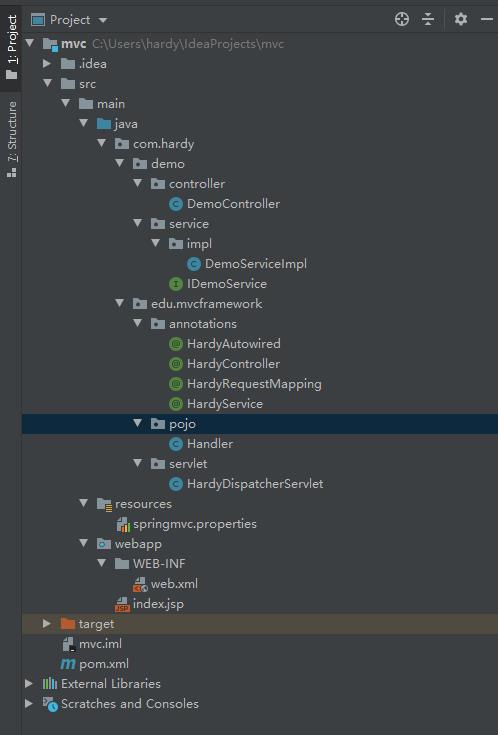
运行结果
使用插件tomcat运行项目,使用debug模式,运行后访问:http://localhost:8080/,控制台会打印:hardy mvc 初始化完成.... 的消息,如下所示:
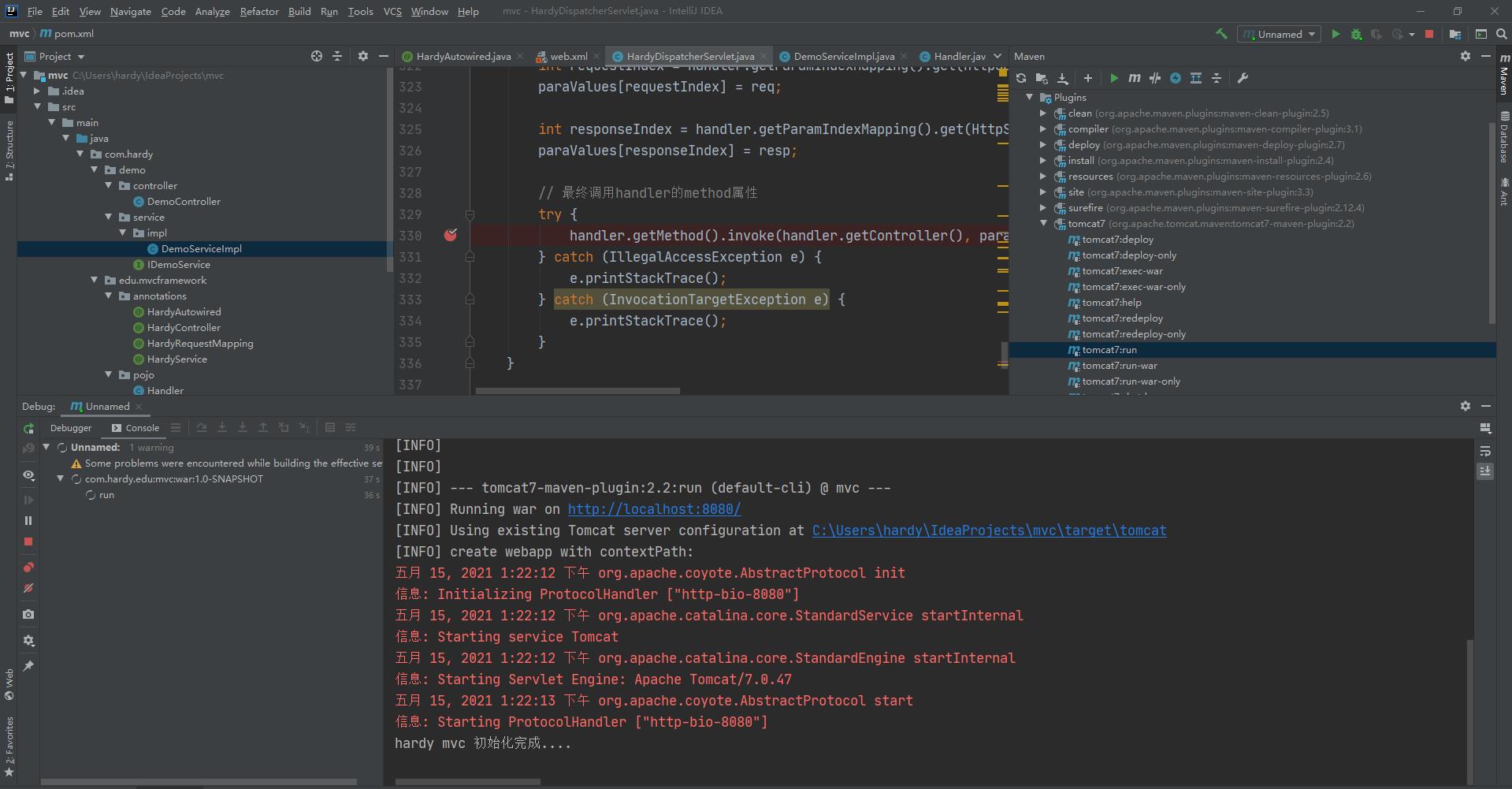
由于没有指明要调用哪个接口,故返回:404 not found,如下所示:

访问我们前面编写好的接口:/demo/query?name=zhangsan,访问结果如下所示:
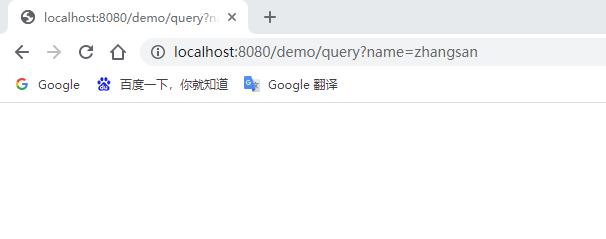
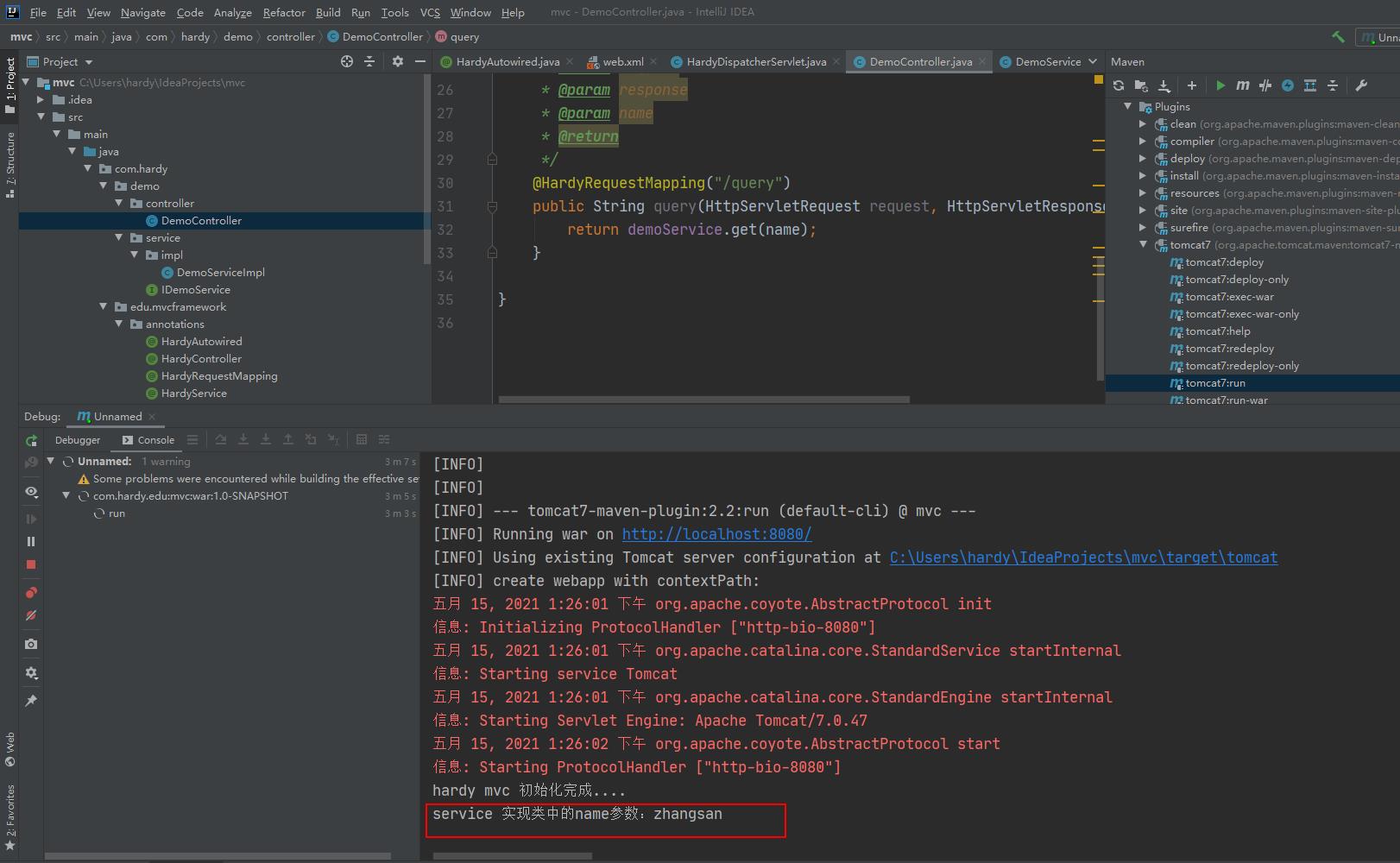
由上述结果可知,因为后端接口没有返回对应的视图,故页面返回结果为空,但控制台确实打印出了我们传递的参数信息,可以看到我们的自定义mvc框架实现了它的基本功能。
分析接口请求参数
最后我们看一下调试打断点时 各个参数的情况,如下图所示,可以看到handler中封装了controller、访问的接口、匹配到的url及参数顺序等信息:
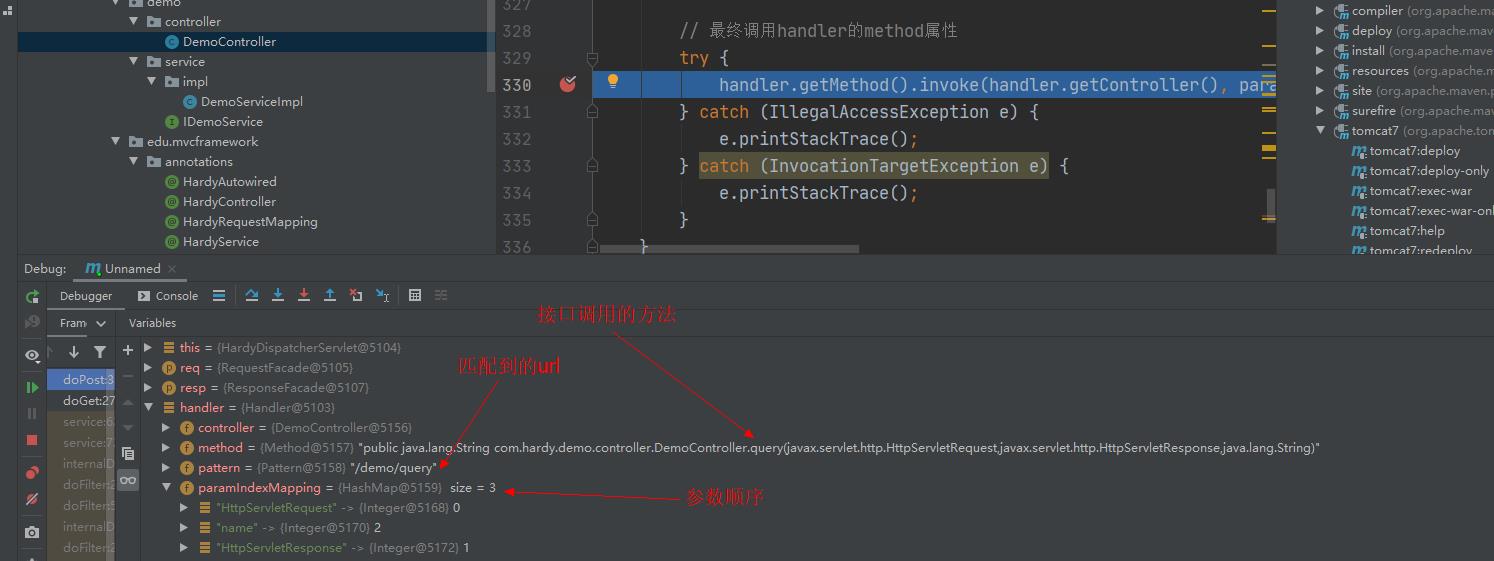
接口请求对应的参数类型及参数值如下所示:

总结
今天我们自定义了一个mvc框架,该框架实现了:加载配置文件、扫描相关的类,扫描注解、Bean初始化以及依赖注入维护、Spring MVC相关组件的初始化、建立url与method之间的映射关系及接受并处理请求的功能。
虽然这里仅仅实现了最基本的功能,但是需要学习的东西也还是挺多的,部分代码也是比较复杂的。
下一篇文章,会在Spring MVC框架的基础上实现访问拦截的功能。
以上是关于手写Spring MVC框架 实现简易版mvc框架的主要内容,如果未能解决你的问题,请参考以下文章